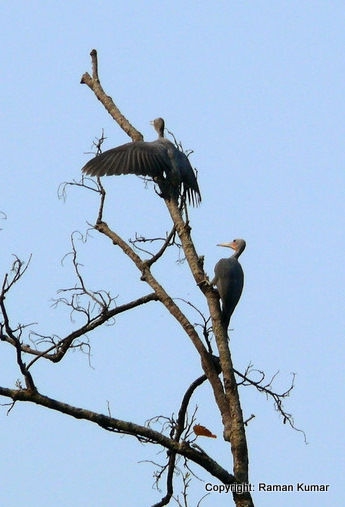| Citation |
|
Description |
Geographic Range [top]
Range Description: Mulleripicus pulverulentus is found in South-East Asia, from northern India through the foothills of the Himalayas to southern China, Nepal (a rare and local resident), Myanmar, Laos, Vietnam, Cambodia and Thailand, and through peninsular Malaysia and Singapore to the western islands of Indonesia and the Philippines (del Hoyo et al. 2002, Inskipp et al. 2011). The current population has been estimated at 26,000-550,000 individuals, which according to previous levels of forest cover may be a 90% decline on historical levels, and a significant decline within the past couple of decades (Lammertink et al. 2009).
Countries occurrence:
Native:
Bangladesh; Bhutan; Brunei Darussalam; Cambodia; India; Indonesia; Lao Peoples Democratic Republic; Malaysia; Myanmar; Nepal; Philippines; Thailand; Viet Nam
Possibly extinct:
China
Regionally extinct:
Singapore
Additional data:
? Continuing decline in area of occupancy (AOO): Unknown
? Extreme fluctuations in area of occupancy (AOO): No ? Estimated extent of occurrence (EOO) - km2: 2510000
? Continuing decline in extent of occurrence (EOO): Unknown ? Extreme fluctuations in extent of occurrence (EOO): No
? Continuing decline in number of locations: Unknown
? Extreme fluctuations in the number of locations: No
? Upper elevation limit (metres): 1100
Range Map: Click here to open the map viewer and explore range.
Population [top]
Population: Based on remote sensing and population density data, the global population has been estimated to number 26,000-550,000 individuals. This figure is revised from 260,000-550,000 individuals, as in many countries extrapolation from forest cover exceeds population numbers that appear reasonable based on anecdotal information about the abundance of the species, as large tracts which are classified as forest in remote sensing data are not occupied by the species (e.g. heath forest).
Trend Justification: The species is estimated to have declined by 40-75% over the last 3 generations, using different calculated generation lengths and declines in forest cover. However, given that there is uncertainty in extrapolating population density trends over such a large range, and the data on forest cover trends used was crude, a decline of 30-49% over the past 20 years (3 generations) seems appropriate (Lammertink et al. 2009).
Current Population Trend: Decreasing
Additional data:
? Continuing decline of mature individuals: Yes
? Extreme fluctuations: No ? Population severely fragmented: No
? Continuing decline in subpopulations: Unknown
? Extreme fluctuations in subpopulations: No ? All individuals in one subpopulation: No
Habitat and Ecology [top]
Habitat and Ecology: Behaviour This resident species breeds between March and May in the west of its range and without a distinct season in South-East Asia (Lammertink 2004). Clutch size is two to four eggs. Nest-hole excavation, incubation and chick-rearing are conducted by both sexes, with helpers at some nests. It forages in noisy groups of three to six individuals and sometimes more (Lammertink 2004). Groups occupy large territories. Habitat It occupies primary semi-open moist deciduous and tropical evergreen old growth, lower elevation forests, as well as adjacent secondary forest and clearings with scattered tall trees. It prefers dipterocarp and teak forests in certain areas, as well as swamp-forest and tall mangroves. It is most frequent in lowlands and lower hills below 600 m, but does occur up to 1,100 m in the Himalayas and occasionally up to 2,000 m. Diet Foraging groups search and exploit nests of social insects (ants, termites, and stingless bees), often in trunks and branches of old live trees. Birds may also take small fruit (Lammertink 2004).
Systems: Terrestrial
Continuing decline in area, extent and/or quality of habitat: Unknown
Generation Length (years): 6.5
Movement patterns: Not a Migrant
Threats [top]
Major Threat(s): It is threatened by habitat destruction, particularly the felling of old-growth forest, though it may persist in heavily logged forests at lower densities (Lammertink et al. 2009). There is no evidence of it being hunted but it is absent from or exceedingly rare at sites in Myanmar and Indochina where wildlife hunting is common (Lammertink in litt. 2012).
Conservation Actions [top]
Conservation Actions: Conservation Actions Underway
No current action is known for this species, although it does occur in many protected areas (del Hoyo et al. 2002).
Conservation Actions Proposed
Research the status of this species at additional sites across its range (Lammertink et al. 2009). Assess density responses to forest disturbance in the Indochinese forest complex (Lammertink et al. 2009). Investigate whether degraded forests can support viable populations (Lammertink et al. 2009). Promote the protection of large tracts of its range, particularly in Myanmar which is thought to be a population stronghold (Lammertink et al. 2009).
Citation: BirdLife International. 2012. Mulleripicus pulverulentus. The IUCN Red List of Threatened Species 2012: e.T22681585A38597348. http://dx.doi.org/10.2305/IUCN.UK.2012-1.RLTS.T22681585A38597348.en. Downloaded on 23 August 2016.
Disclaimer: To make use of this information, please check the .
Feedback: If you see any errors or have any questions or suggestions on what is shown on this page, please provide us with feedback so that we can correct or extend the information provided
|

